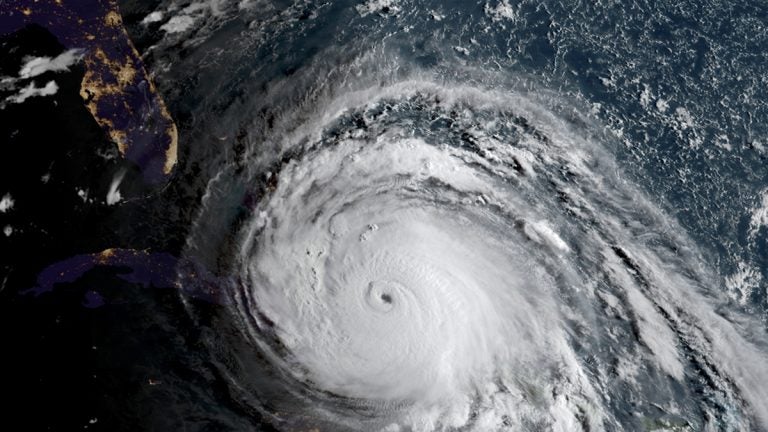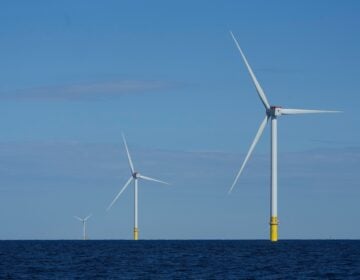Irma taking aim at Tampa as Floridians hustle to evacuate

In this geocolor image GOES-16 satellite image taken Friday, Sept. 8, 2017, at 11:45 UTC, sunlight, from the right, illuminates Hurricane Irma as the storm approaches Cuba and Florida. (NOAA via AP)
With the window closing fast for anyone wanting to escape, Irma hurtled toward Florida with 130 mph winds Saturday on a shifting course that threatened the first direct hit on the Tampa area from a major hurricane in nearly a century.
Forecasters predicted Irma’s center would blow ashore Sunday and strike the Florida Keys, then hit southwestern Florida, move up the state’s Gulf Coast and plow into the Tampa Bay area.
The storm center is expected to miss the Miami metropolitan area of 6 million people — which for days had been expecting to get hit head-on — but it will still be pounded with life-threatening hurricane winds, National Hurricane Center spokesman Dennis Feltgen said.
The Tampa Bay area has not been struck by a major hurricane since 1921.
On Saturday morning, the hurricane’s outer bands blew into South Florida as residents scrambled to leave. Damaging winds were moving into areas including Key Biscayne and Coral Gables, and gusts up to 56 mph (90 kph) were reported off Miami.
Irma was expected to pick up strength again as it closed in on Florida.
In one of the biggest evacuations ever ordered in the U.S., about 5.6 million people in Florida — more than one-quarter of the state’s population — were told to leave, and 540,000 were ordered to clear out from the Georgia coast. Authorities opened hundreds of shelters for people who did not leave. Hotels as far away as Atlanta filled up with evacuees.
“If you are planning to leave and do not leave tonight, you will have to ride out this extremely dangerous storm at your own risk,” Florida Gov. Rick Scott said Friday. He urged everybody in the Keys to get out.
Ray Scarborough and girlfriend Leah Etmanczyk left their home in Big Pine Key and fled north with her parents and three big dogs to stay with relatives in Orlando. Scarborough was 12 when Hurricane Andrew hit in 1992 and remembers lying on the floor in a hallway as the storm nearly ripped the roof off his house.
“They said this one is going to be bigger than Andrew. When they told me that, that’s all I needed to hear,” said Scarborough, now a 37-year-old boat captain. “That one tore everything apart.”
Their house in the Keys, up on 6-foot (1.8-meter) stilts, has flooded before.
“This isn’t our first rodeo. Andrew was a wicked storm. Wilma was a wicked storm. This one is going to be worse. Then we’ll go home and rebuild, like we always do,” said Etmanczyk, a 29-year-old teacher.
Forecasters adjusted the storm’s potential track more toward the west coast of Florida, away from the Miami metropolitan area of 6 million people, meaning “a less costly, a less deadly storm,” University of Miami researcher Brian McNoldy said.
Nevertheless, forecasters warned that its hurricane-force winds were so wide they could reach from coast to coast, testing the adequacy of the more stringent hurricane building codes adopted in the last decade or so.
Gas shortages and gridlock plagued the evacuations, turning normally simple trips into tests of will. Parts of interstates 75 and 95 north were bumper-to-bumper, while very few cars drove in the southbound lanes.
In suburban Palm Beach County on the state’s Atlantic coast, the streets were nearly deserted early Saturday as the first squall from Irma dropped a brief shower over the area. Gas stations ran out of fuel, grocery stores were closed and only a few fast-food restaurants were open.
Sherry Whiteside, a Palm Beach Gardens mental health counselor, had come to her neighborhood Publix because she was craving a cherry pie. The store was closed. She held out hope for the state.
“I am praying that it will somehow disintegrate or — what’s that word? — dissipate,” she said.
Andrew razed Miami’s suburbs with winds topping 165 mph (265 kph), damaging or blowing apart over 125,000 homes. Almost all mobile homes in its path were obliterated. The damage in Florida totaled $26 billion and at least 40 people.
___
Galofaro reported from Orlando. Associated Press writers Seth Borenstein in Washington; Terry Spencer in Palm Beach County; Gary Fineout in Tallahassee, Terrance Harris in Orlando and David Fischer in Miami contributed to this report.
WHYY is your source for fact-based, in-depth journalism and information. As a nonprofit organization, we rely on financial support from readers like you. Please give today.




